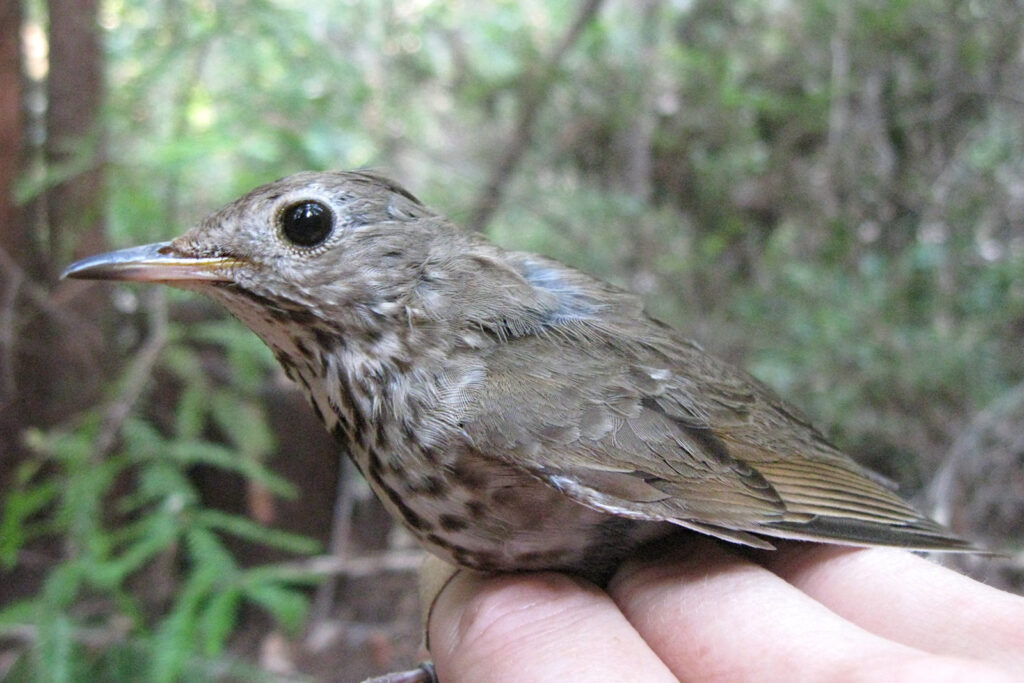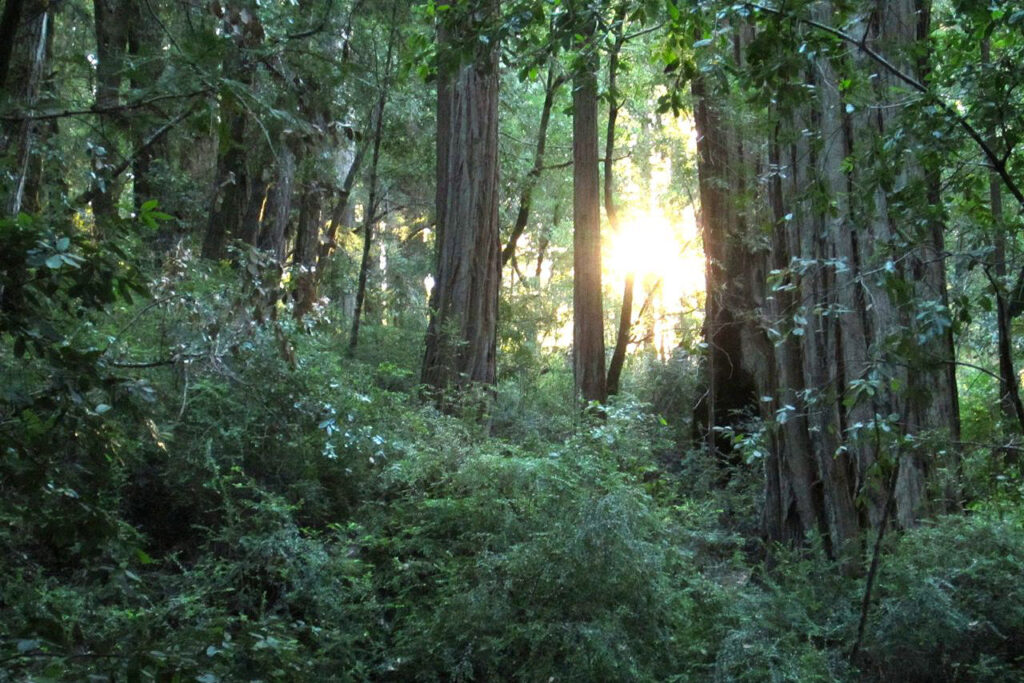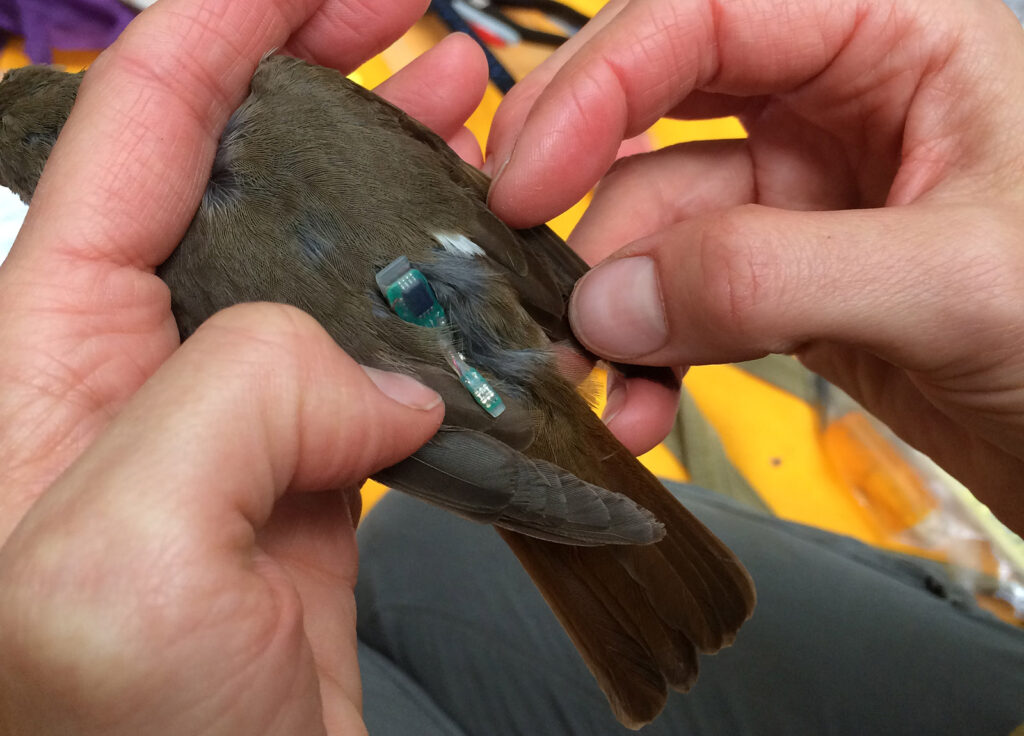When my husband and I moved from New Hampshire to the San Francisco Bay Area in 2001 and started home hunting, my requirements for an apartment were the following: 1) allows dogs, 2) easy access to public transport, and 3) singing Hermit Thrushes within earshot. I realized after some preliminary study that this was pretty optimistic given that Hermit Thrushes don’t breed in the immediate Bay Area, though they may be inclined to visit one’s yard in winter. Interestingly, however, if one heads to the nearby Coast Ranges along the Pacific in summer, you might hear an individual of the Catharus guttatus slevini subspecies singing, concealed in the dim understory of a Douglas-fir or Coast redwood grove.
My fascination with these thrushes’ confounding migration pattern—in which individuals winter commonly across a breadth of elevations but leave to breed elsewhere, and other individuals breed at nearby high elevations but depart to winter elsewhere—started me on a journey to reveal the species’ migratory geography along the west coast of the United States. Hermit Thrush geolocator research with colleagues from San Francisco Bay Bird Observatory and Point Blue Conservation Science (Nelson et al. 2016) identified Pacific Northwestern breeding areas of the Bay Area’s wintering birds. Before I had wrapped that work up for my MS thesis, however, I was already on the trail of the breeders (and their mesmerizing songs), in Big Basin Redwoods State Park.
Big Basin holds the largest continuous stand of ancient coast redwoods (Sequoia sempervirens) south of the SF Bay, and there is nothing quite as magical as the countersinging of Hermit Thrushes reverberating through the still of these colossal, primeval trees at first light. Though the Hermit Thrush is considered common across its broad North American range, Big Basin is essentially the southernmost extent of this subspecies’ very limited breeding range along the coast of California. In fact, Hermit Thrushes are now relatively uncommon in Monterey County, where the subspecies’ type specimen was collected, likely an unfortunate consequence of coastal development. To better understand the migration of this geographically constrained population of Hermit Thrushes, we applied light-level geolocators (funded via a Kickstarter) to 20 of Big Basin’s breeding birds in 2014.
Hermit Thrushes exhibit high site-fidelity, making them ideal candidates for geolocator application, which requires the recapture of the individual for tag removal and data download. In 2015, we were fortunate enough to retrieve 13 of 20 geolocators, an unusually high recapture rate. I attribute this to a number of factors. Because Hermit Thrushes sing at dusk as well as dawn, we identified territories the night prior and set up nets near favored perches, so we were ready at first light to catch a bird as soon as he started singing. Our capture success improved further after we recorded a local bird and played back his song, rather than one prerecorded, to lure individuals into nets. And though tissue sampling is generally quite safe for birds, we chose to collect blood and feather samples (for future genomics work) when the birds returned, rather than the time of tag deployment.
Geolocator analysis is not, let’s say, straightforward, and can be further complicated when topography of tagging locations varies between individuals. Our two field sites were approximately 2 km apart, with one having greater variation in elevation and a primarily southwestern aspect, and the other oriented primarily northeastward. My volunteers and I became very familiar with one steep switchback trail that hosted several pairs of Hermit Thrushes along its length—up and down, up and down, carrying poles, speakers, and tagging and sampling materials. The variation between the two sites likely complicated tag analysis, which we ultimately addressed by using a Hill-Ekstrom calibration to estimate wintering locations.
So where did the birds spend their winters? Baja California Sur and western mainland Mexico, flying an average of 1617 km in an average of 22.5 days. It’s possible that this migration represents an example of habitat tracking; C. g. slevini is the smallest and one of the palest subspecies of the Hermit Thrush yet sports the longest bill, possibly adaptations to the relatively warm, dry climate it experiences on both winter and breeding grounds.
Future studies will need to determine whether the C. g slevini subspecies designation reflects unique genetic markers and define the geographic limits of this taxon. This is essential considering the threat of climate change this population faces on both wintering and breeding grounds: in August 2020, over 95% of Big Basin Redwoods State Park was burned in the high severity CZU Lighting Complex fires. Hermit Thrushes nest on or near the ground, but almost zero understory remains in the park to date. Funded with a grant from California State Parks Foundation, I will be returning to Big Basin in summer 2021 to examine the effects this fire may have had on the park’s Hermit Thrush population.
The results of our Big Basin Hermit Thrush geolocator study were recently published in Journal of Field Ornithology:
Nelson, A. R. P., W. T. Wiskes, and N.E. Seavy. 2021. Wintering destinations of Monterey Hermit Thrushes (Catharus guttatus slevini). Journal of Field Ornithology 92:43-53. https://doi.org/10.1111/jofo.12357.
Guest post by:
Allison R. Paules Nelson, MS
Gold Country Avian Studies
Header photo: Navopatia Field Station in coastal western mainland Mexico, where Hermit Thrushes have been captured in mid-winter. Photo: Navopatia FS.




